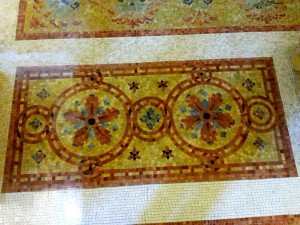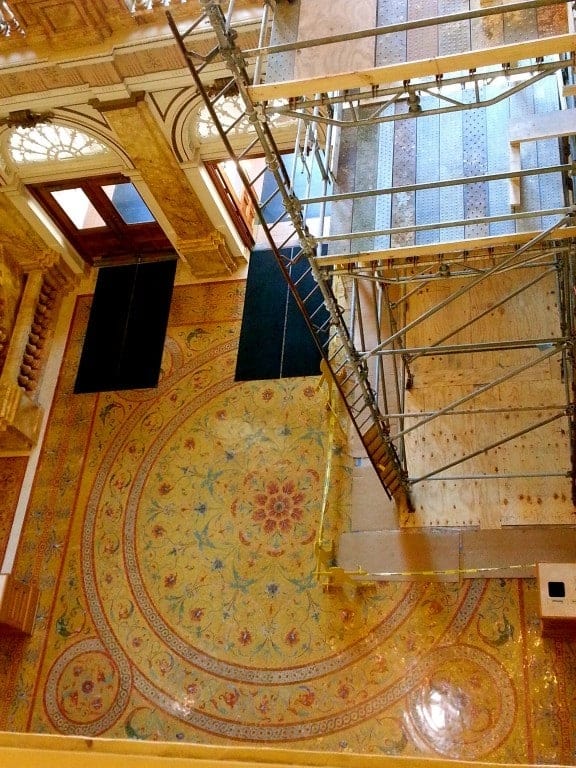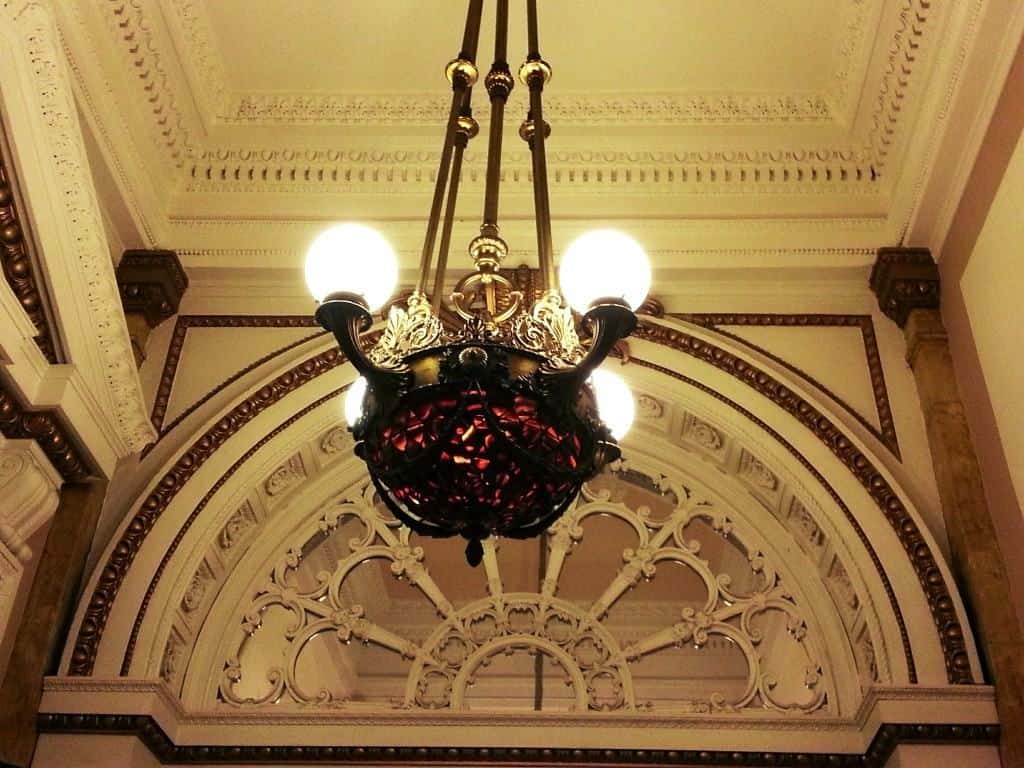When you’re ten years old, you skitter along, dodging bulky objects, confused by it all. One afternoon, I left the confines of my mother’s overweight Oldsmobile and ran up to a palace — up the granite steps between weatherbeaten candelabra and through the heavy door with its brass fittings marked “MPL”: Milwaukee Public Library. I was inside.
I had come downtown to find some old copies of Life for a report on World War II. I would find those, on rolls of microfilm that I perused on a rear-projection viewscreen five times larger than my head. But as I came in from the curb, I entered a sanctuary that made me stop: a foyer with no function other than to awe.
I was at the bottom of a yellow marble cavern, balustrades all around, miles beneath a coffered cupola framed by eagles and studded (in a flourish that some might call de trop) with electric lightbulbs. Underfoot, thousands of tesserae blurred together in a vaguely botanical mosaic. This being Milwaukee, and wintertime, someone had obscured the floor with non-slip rubber mats to catch the sidewalk salt. I took a breath.
Through the next doors and past the intimidating owls at the Circulation Desk, awe turned to exhilaration. The brightly-lit floors opened up in front of me onto towering steel bookshelves and hundreds of grown-up people frowning over open volumes on long tables, reading newspapers spindled on bamboo rods or rifling through the drawers of card catalogs while noting odd alphanumeric sequences on tiny white slips with golf pencils. It was a factory for acquiring information, and the drunks lounging in dirty raincoats and the lurid American Library Association posters of a grinning Bill Cosby exhorting “READ” could not dampen the dynamism or dim the dignity of the place.
Upstairs was where the periodicals were kept, as I was informed by signs (as I remember them) suspended from the ceiling. I chose the right side of the twin staircase and ascended with liturgical dignity, like a visiting official or Eliza Doolittle at the ambassador’s ball. It was a grand moment.
I recently rediscovered an architectural case study of the Milwaukee Central Library that reminded me of my childhood adventure. The author, who is a friend, exposes the carefully-engineered underpinnings of my wonderment. She mixes little-known facts with a cultural interpretation I found bracing and honest.
We may not share all of the assumptions of the nineteenth century, when the Library was built. But we can learn about them and — perhaps — learn from them. Lady Salisbury, shortly before she died in November 1899, said to a young relative: “The young generation may criticize us as they like; will they ever provide anything as good as what we have known?” (Barbara W. Tuchman, The Proud Tower)
Architecture Case Study: Milwaukee Central Library (1898)
Architects understand that their buildings will shape people’s minds and color their emotions as well as shelter their bodies.
The Milwaukee Central Library captivates me on several levels.
First, there is its site: I want to look at how the site was chosen, and how it evolved once the Library began its life.
Then, there is the culture that shaped the Library’s design before a single stone was laid: what were the cultural assumptions of the men (and they were men) who planned and built the Library? What did they believe a library should do and be?
Lastly, I want to examine the Library as a physical fact: how and with what materials was it built? What does its size communicate? What messages is this building sending out to us in architectural code?
The Site
The city fathers who first planned the Library building hoped it would exude symbolic meaning. The first tangible sign of that intention is the site they chose: a preserve of wild oaks and maples known as Mozart’s Grove. Why Mozart? Because classical music was performed among the trees. That linked the site to culture. Before the Library, Milwaukeeans came to this site to absorb culture — European, and specifically Germanic, culture — in a setting that spoke to the traditional German reverence for nature.
As if to reinforce the connection to the Vaterland, the Library is immediately south of a stately mansion then called the Deutscher Club, or German Club. (Today, it is the Wisconsin Club.) That made this site prestigious and put it on “German turf,” rather than in the smaller Polish or English-speaking neighborhoods, for example. The site was near the geographical center of the city, implying that the Library would be in Milwaukee’s “heart.”
After the Library was built, it began to enhance its own site by drawing other cultural institutions to its sides. The neighborhood we see around the Library today is partly a result of the Library creating an atmosphere of civic prestige for its street and immediate neighborhood. The Library stands on Wisconsin Avenue, arguably the main street of Milwaukee’s downtown. It shares this street with a major university, Marquette, and a massive church, Gesù. Further down Wisconsin Avenue are the Convention Center, five major skyscrapers, the city’s largest insurance firm (Northwestern Mutual), the Federal Courthouse, the largest bank, and the Art Museum. One block behind the library are the massive County Courthouse and the Public Museum. Three major patriotic monuments, complete with bronze statues, punctuate the street immediately in front of the Library. Most of these structures were built after the Library itself.
The grove of trees, representing the natural environment of the site, is long gone, but the Library is now the anchor of a man-made cultural ecosystem of important public buildings. The Library has effectively made its neighborhood important.
The Culture Behind the Library
The Library grows richer in meaning when we look at the cultural climate in which it was built. Businessmen and politicians planned the Library, and they had a message to deliver. They used the vocabulary of architecture to communicate, first and foremost, their European heritage. They also used the Library as a declaration of future intentions, a focal point of civic pride, and a billboard advertising their own wealth. The building we have today is an artifact of this nineteenth-century European immigrant environment. The biases of those people, their values, and their ambitions are marked plainly on the Library’s facade.
The men who controlled Milwaukee in the nineteenth century were mostly German or German-American. It is hard for us to understand how close these late-nineteenth-century Milwaukeeans felt to Germany. The World Wars had not yet occurred, so Germany was not particularly stigmatized in America. Milwaukee public schools taught in German, and pastors preached in German in the churches. The Germans were community-minded and reverent towards culture, nostalgic for Europe, and ambitious in the New World, and the Library would express those traits. By building a massive public structure, the community was showing what it could do and how rich it had become. By filling the building with books (and, originally, with a museum as well) they declared that culture and learning were cherished here. The very languages in which the books were printed, including a very hefty dose of German, announced that European intellectual traditions had not been forgotten.
The Library’s planners insisted that the architectural vocabulary of their building communicate their European legacy in very clear terms. This was clear from the start, in the choice made by the selection committee that sifted through seventy architectural proposals for the Library. The forward-looking design of a young Frank Lloyd Wright was rejected. Instead, the committee chose a famous local team, Ferry and Clas, who could be counted on to deliver a solid, traditional product.
Ferry and Clas’s design was profoundly European. On the surface, it was very literally German — the plans were a near copy of a library built in the same period in Leipzig, Germany. That must have delighted German Milwaukeeans. On a more symbolic level, too, the Milwaukee Public Library communicated a European worldview. In its materials, its form, and its ornamentation it makes reference to the whole sweep of European architectural history, from the Greeks and Romans through the Italian Renaissance and French Baroque. It is a stone-and-mortar announcement that the people of Milwaukee were European and intended to remain so.
The biases of the men who planned the library went beyond the historical or cultural. They also made assumptions about what a library should do. The massive facade of the building, like its rich interior, told library users that they were on sacred ground. The proper attitude was one of silent attentiveness touched with awe. A person approaching the Library was going there to learn in silence, not to speak out or share his own personal point of view. The Library was there to edify, not listen to what you had to say.
The Library was the dwelling place of the Great Books, produced by the Great Minds, and the founders of the Library, like most educated Americans and Europeans of their time, had in mind an exact list of just which thinkers were great. It would have been hard to find a single non-European on that list, except perhaps Confucius.
The Physical Aspects of the Library
The Library’s last layer of meaning is contained in the material used to make it.
The traditional methods by which the library was built, the dimensions the architects chose for their building, the costly and permanent materials they used, and the symbolic language of the Library’s decoration form the ultimate link between the ideas that brought about the Library and the material structure we see today.
The Library’s frame is constructed of cast iron girders, a relatively new technology at the time. The internal structural support allowed the building to be taller and wider than it could have been otherwise, and enabled the architects to build larger windows and thinner walls. Yet, as with all architects before the Modernists, the goal of the Library’s architects was to disguise the metal skeleton as thoroughly as possible.
And so, in every other respect but its frame, the Library is stubbornly traditional. The entire exterior is faced in Bedford limestone. Grecian columns of the ornate Corinthian order are partially embedded in the façade, as if they were supporting the building. The space between columns is enhanced, on the first floor, by miniature columns of the simple Doric order and wreaths carved in relief. The wreaths are a direct quotation from the Baroque style pushed forward in France under Louis XIV. The first-floor window arches are topped by small scrolls and carved stone leaves, again recalling the Classical European world.
Atop the whole structure sits a massive dome, completely unnecessary from a functional point of view, but symbolically linking the Library with Roman architecture. As if the Roman connection were not clear enough, two massive bronze eagles frame the dome. Eagles were a symbol of the emperor in ancient Rome, as well as of the chief god, Jupiter or Zeus. In this context, they may be interpreted as patriotic American eagles, too.
Inside the Library, the space under the dome forms a Great Hall with an exquisitely-colored mosaic floor (Rome again), two staircases with hundreds of Sienna marble pilasters (both the material and the shape of the railings recall the Italian Renaissance) and countless other embellishments in hardwood, stucco, and brass.
In nearly every detail, this building is recalling some piece of the European past. In its symbolic language, the Library nearly never acknowledges that it was built in the New World and in the late nineteenth century. Profuse ornamentation, the use of luxurious stone, and dozens of structurally-useless columns are what distinguish this building from the twentieth-century structures that were to follow. You have to go further down Wisconsin Avenue to see buildings that would have pleased Mies Van Der Rohe with unadorned right angles and naked steel.
The craft methods by which the Library was constructed are also important. The Library was supposed to be as permanent as it was grand. That necessitated craftsmanship — painstaking work in durable materials by trained men.
Photos from the Library’s archive show individual men in overalls standing, in one instance, next to the four-foot-tall Corinthian capital on one of the dozens of exterior columns. One single man with a hammer and chisel is carving each leaf on the capital by hand. This is where the ambition to imitate a classical building and the actual duplication of a classical building come together in the Library. The craftsman is not merely replicating an ancient Greek design based on the leaves of the acanthus, a prickly relative of the artichoke. He is actually producing a Corinthian capital with methods very similar to those the ancient Greeks used. With the spread of electric tools just a few years later, the old chisel and hammer would be replaced. But at the time the Library was built, skilled masons, marble workers, and mosaic artists used methods that physically linked them with craftsmen from 3000 years ago.
So it can be said that European immigrants had truly produced a great European building in Milwaukee. The craft methods used in the Library’s construction carry familiar messages: continuity with the European past, permanence, pride, and prestige. These ideas were literally hammered into every crevice of the Library’s forehead.
A Declaration in Stone
The Milwaukee Central Library, like every serious building, is an idea made real. It is a set of thoughts, biases, and experiences expressed in stones and mortar. The Library’s architectural messages were not meant to be obscure. This building instructs us in a loud, firm voice.
Through the choice of site, the cultural references in the design of the Library, and the methods and materials used to make the building, the Library brings us messages straight out of nineteenth-century German America. It tells us to remember Europe, revere learning, honor tradition and craftsmanship, and by all means prosper in the New World.
The Library is a “‘message-building” — an allegorical structure. It is a building of ideas, but it is also a magnificent physical object, the product of excellent materials and careful labor. In the end, for better or very much worse, the physical facts of the library — its sturdiness and beauty — may far outlive the cultural assumptions it represents.







